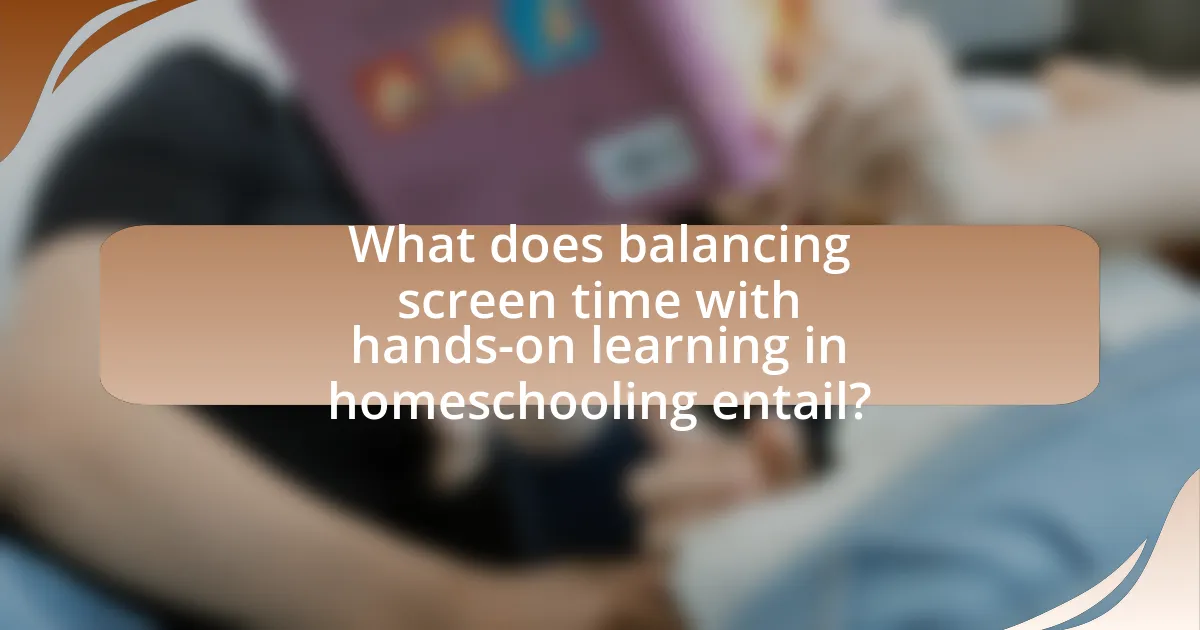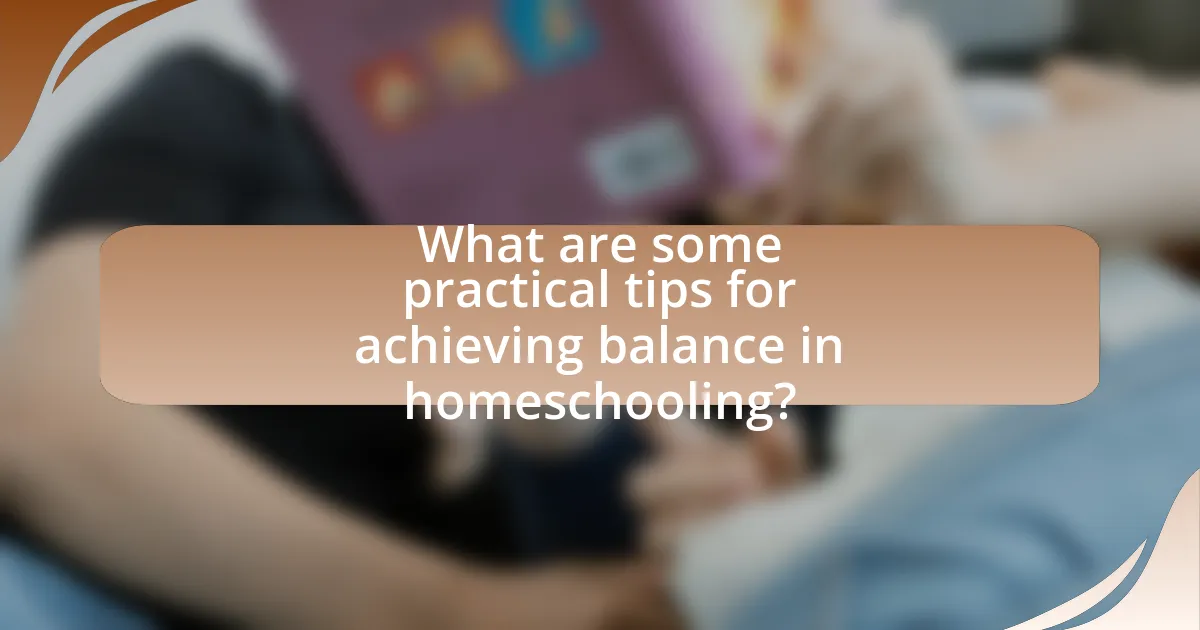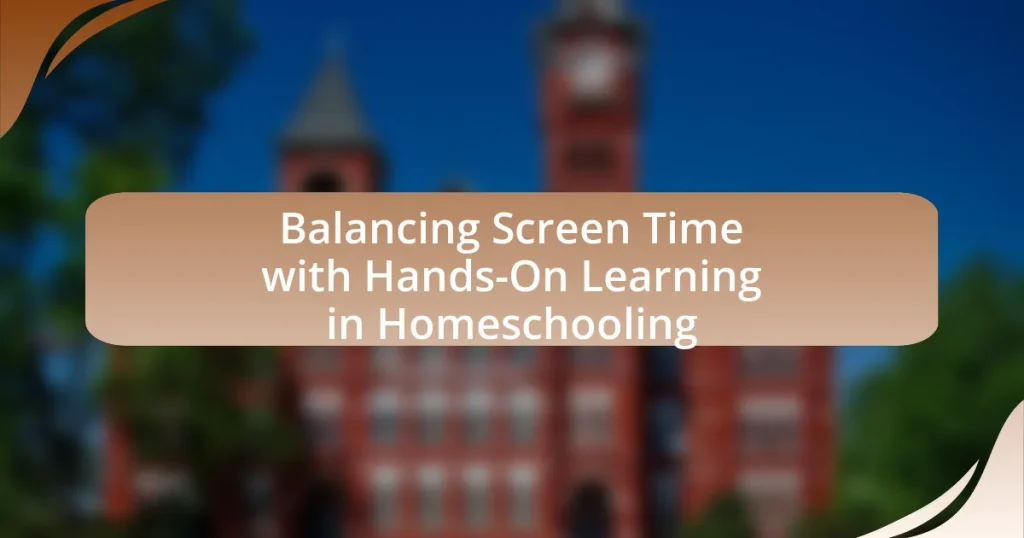The article focuses on the importance of balancing screen time with hands-on learning in homeschooling. It outlines how integrating digital educational resources with practical activities can enhance learning outcomes by catering to various learning styles. Key topics include effective integration of screen time into curricula, the benefits of hands-on learning, challenges in achieving balance, and strategies for parents to create a structured homeschooling schedule. Additionally, it discusses the role of community resources and technology in facilitating a well-rounded educational experience.

What does balancing screen time with hands-on learning in homeschooling entail?
Balancing screen time with hands-on learning in homeschooling entails integrating digital educational resources with practical, experiential activities to enhance learning outcomes. This approach recognizes the benefits of technology, such as access to diverse information and interactive learning tools, while also emphasizing the importance of tactile experiences that foster critical thinking, creativity, and problem-solving skills. Research indicates that children learn effectively through a combination of visual, auditory, and kinesthetic methods, supporting the need for a balanced educational strategy that includes both screen-based and hands-on activities.
How can screen time be effectively integrated into a homeschooling curriculum?
Screen time can be effectively integrated into a homeschooling curriculum by utilizing educational software and online resources that align with learning objectives. For instance, platforms like Khan Academy and Duolingo provide structured lessons that enhance subjects such as math and language learning, making them suitable for homeschooling. Research indicates that blended learning approaches, which combine traditional teaching methods with digital tools, can improve student engagement and retention of information. A study published in the Journal of Educational Psychology found that students who used interactive digital content performed better in assessments compared to those who relied solely on textbooks. Therefore, incorporating screen time through targeted educational applications can enhance the overall learning experience in a homeschooling environment.
What types of educational content are best suited for screen time?
Interactive educational games and videos are best suited for screen time. These types of content engage learners actively, promoting critical thinking and problem-solving skills. Research indicates that interactive media can enhance learning outcomes; for instance, a study published in the Journal of Educational Psychology found that students who used interactive simulations scored significantly higher on assessments compared to those who engaged with traditional learning materials. Additionally, educational platforms like Khan Academy and PBS Kids offer content that aligns with curriculum standards, making them effective tools for reinforcing concepts taught in a homeschooling environment.
How can screen time enhance learning outcomes in homeschooling?
Screen time can enhance learning outcomes in homeschooling by providing access to diverse educational resources and interactive learning tools. Digital platforms offer a wide range of subjects, enabling personalized learning experiences that cater to individual student needs. For instance, studies show that students using educational software demonstrate improved engagement and retention of information, as interactive elements can reinforce concepts more effectively than traditional methods. Additionally, screen time can facilitate collaboration through online forums and virtual classrooms, allowing students to connect with peers and educators globally, which further enriches their learning experience.
Why is hands-on learning important in a homeschooling environment?
Hands-on learning is important in a homeschooling environment because it enhances engagement and retention of knowledge. Research indicates that experiential learning, which includes hands-on activities, leads to better understanding and memory retention compared to traditional lecture-based methods. For instance, a study published in the Journal of Educational Psychology found that students who participated in hands-on learning activities scored significantly higher on assessments than those who did not. This approach allows students to apply concepts in real-world contexts, fostering critical thinking and problem-solving skills essential for their development.
What are the key benefits of hands-on learning for children?
Hands-on learning provides children with practical experience that enhances their understanding and retention of concepts. This experiential approach engages multiple senses, which research indicates can lead to improved cognitive development and problem-solving skills. For instance, a study published in the Journal of Educational Psychology found that students who participated in hands-on activities scored significantly higher on assessments compared to those who learned through traditional methods. Additionally, hands-on learning fosters collaboration and communication skills as children often work in groups, promoting social interaction and teamwork.
How does hands-on learning support different learning styles?
Hands-on learning supports different learning styles by engaging multiple senses and facilitating experiential learning, which caters to visual, auditory, and kinesthetic learners. For instance, kinesthetic learners benefit from physical interaction with materials, while visual learners gain understanding through demonstrations and visual aids. Research by Kolb (1984) on experiential learning theory emphasizes that active participation enhances retention and comprehension across diverse learning preferences. This approach allows learners to connect theoretical concepts with practical applications, reinforcing their understanding and accommodating various educational needs.
What challenges arise when balancing screen time and hands-on learning?
Balancing screen time and hands-on learning presents challenges such as reduced engagement in physical activities and potential over-reliance on digital resources. When children spend excessive time on screens, they may miss out on critical sensory experiences and motor skill development that hands-on learning provides. Research indicates that children who engage in more hands-on activities demonstrate better problem-solving skills and creativity compared to those who primarily learn through screens. Additionally, managing screen time can lead to conflicts between parents and children regarding acceptable limits, which can create stress in the homeschooling environment.
How can parents identify when screen time is excessive?
Parents can identify excessive screen time by observing behavioral changes, such as increased irritability, difficulty concentrating, or withdrawal from social interactions. Research indicates that children aged 2 to 5 should have no more than one hour of high-quality screen time per day, while those aged 6 and older should have consistent limits to ensure it does not interfere with sleep, physical activity, and other healthy behaviors. The American Academy of Pediatrics emphasizes that excessive screen time can lead to negative outcomes, including obesity and sleep problems, reinforcing the need for parents to monitor and set boundaries on screen usage.
What strategies can be employed to mitigate the challenges of balancing both approaches?
To mitigate the challenges of balancing screen time with hands-on learning in homeschooling, parents can implement a structured schedule that allocates specific time blocks for each approach. This strategy allows for a clear distinction between screen-based activities and hands-on learning, ensuring that neither approach overshadows the other. Research indicates that a balanced schedule can enhance cognitive development, as it encourages diverse learning experiences. For instance, a study published in the Journal of Educational Psychology found that students who engaged in both digital and tactile learning showed improved problem-solving skills compared to those who focused solely on one method. By using timers or visual schedules, parents can effectively manage transitions between activities, reinforcing the importance of both learning modalities.

How can parents create a balanced homeschooling schedule?
Parents can create a balanced homeschooling schedule by integrating both screen time and hands-on learning activities. This approach allows for a diverse educational experience that caters to different learning styles. Research indicates that a balanced schedule should allocate specific time blocks for digital learning, such as online courses or educational videos, alongside practical activities like experiments, arts and crafts, or outdoor exploration. For instance, the American Academy of Pediatrics recommends that children aged 2 to 5 years should have no more than one hour of high-quality programming each day, emphasizing the importance of interactive and engaging content. By alternating between these modes of learning, parents can ensure that their children remain engaged and receive a well-rounded education.
What factors should be considered when planning a daily routine?
When planning a daily routine, key factors include time management, learning objectives, and the balance between screen time and hands-on activities. Effective time management ensures that each activity has a designated time slot, promoting productivity and focus. Establishing clear learning objectives helps in selecting appropriate activities that align with educational goals. Additionally, balancing screen time with hands-on learning is crucial; research indicates that excessive screen time can hinder cognitive development, while hands-on activities enhance critical thinking and problem-solving skills. For instance, a study by the American Academy of Pediatrics emphasizes the importance of interactive play and physical activities for children’s development, supporting the need for a well-rounded daily routine.
How can parents allocate time for both screen-based and hands-on activities?
Parents can allocate time for both screen-based and hands-on activities by creating a structured schedule that designates specific time blocks for each type of activity. For instance, parents can set aside two hours in the morning for hands-on learning, such as arts and crafts or science experiments, followed by one hour of screen-based learning, like educational videos or interactive apps. Research indicates that a balanced approach enhances cognitive development; a study published in the journal “Pediatrics” found that children benefit from a mix of digital and physical learning experiences, leading to improved engagement and retention of information. By implementing this structured approach, parents can effectively manage their children’s time, ensuring a well-rounded educational experience.
What tools can assist in creating an effective homeschooling schedule?
Digital planners and scheduling apps, such as Google Calendar and Trello, can assist in creating an effective homeschooling schedule. These tools allow parents to organize lessons, track progress, and allocate time for both screen-based and hands-on learning activities. Research indicates that structured schedules enhance learning outcomes by providing consistency and routine, which are crucial for effective homeschooling. For instance, a study published in the Journal of Educational Psychology found that students with well-organized study schedules performed better academically compared to those without.
How can parents assess the effectiveness of their balance between screen time and hands-on learning?
Parents can assess the effectiveness of their balance between screen time and hands-on learning by observing their children’s engagement, retention of information, and overall development. Monitoring how well children apply skills learned through both methods in real-life situations provides insight into the effectiveness of the balance. Research indicates that children who engage in a mix of screen time and hands-on activities demonstrate improved cognitive and social skills, as evidenced by a study published in the journal “Pediatrics,” which found that interactive screen time can enhance learning when combined with physical activities. Additionally, parents can utilize feedback from children regarding their preferences and learning experiences to adjust the balance accordingly.
What indicators show that a child is benefiting from the current balance?
Indicators that a child is benefiting from the current balance of screen time and hands-on learning include improved engagement in activities, enhanced problem-solving skills, and increased retention of information. When children actively participate in hands-on learning, they often demonstrate higher levels of interest and motivation, which can be observed through their willingness to explore and ask questions. Research indicates that children who balance screen time with interactive learning experiences show better cognitive development, as evidenced by studies linking hands-on activities to improved critical thinking skills. Additionally, parents may notice that children can recall information more effectively when it is learned through a combination of digital and tactile methods, reinforcing the effectiveness of this balanced approach.
How can feedback from children inform adjustments to the balance?
Feedback from children can inform adjustments to the balance of screen time and hands-on learning by providing insights into their engagement and preferences. When children express their enjoyment or frustration regarding specific activities, educators and parents can analyze this feedback to determine which methods are most effective. For instance, a study by the American Academy of Pediatrics highlights that children learn better when they are actively engaged, suggesting that feedback indicating a preference for hands-on activities can lead to a reduction in screen time in favor of more interactive learning experiences. This direct input allows for a more tailored educational approach that aligns with children’s needs and enhances their overall learning outcomes.

What are some practical tips for achieving balance in homeschooling?
To achieve balance in homeschooling, implement a structured schedule that allocates specific time for both screen-based learning and hands-on activities. Research indicates that children benefit from a mix of learning modalities; for instance, the American Academy of Pediatrics recommends limiting screen time to ensure it does not interfere with physical activity and face-to-face interactions. Incorporating a variety of subjects and activities, such as outdoor exploration, arts and crafts, and interactive educational games, can enhance engagement and retention. Additionally, regularly assessing your child’s progress and adjusting the balance based on their needs and interests can lead to a more effective and enjoyable homeschooling experience.
How can parents incorporate hands-on learning into screen-based lessons?
Parents can incorporate hands-on learning into screen-based lessons by integrating interactive activities that complement digital content. For example, while using educational videos on science, parents can conduct simple experiments at home that illustrate the concepts discussed in the video. This approach not only reinforces learning but also engages children actively, making the material more relatable and memorable. Research shows that experiential learning enhances retention; a study by the National Training Laboratories indicates that hands-on activities can improve retention rates to 75% compared to 5% for lecture-based learning. By combining screen-based lessons with practical applications, parents can create a balanced educational experience that fosters deeper understanding and engagement.
What activities can complement screen time to enhance engagement?
Activities that can complement screen time to enhance engagement include hands-on projects, outdoor exploration, and interactive discussions. Hands-on projects, such as crafting or science experiments, allow learners to apply concepts from screen-based content in a tangible way, reinforcing understanding and retention. Outdoor exploration, like nature walks or gardening, provides real-world context to digital learning, promoting curiosity and physical activity. Interactive discussions, whether in-person or virtual, encourage critical thinking and collaboration, allowing learners to articulate their thoughts and engage with peers. Research indicates that combining screen time with these activities can lead to improved cognitive outcomes and greater overall engagement in learning.
How can parents use technology to facilitate hands-on learning experiences?
Parents can use technology to facilitate hands-on learning experiences by integrating interactive educational apps and online resources that promote active engagement. For instance, platforms like Tinkercad allow children to design and create 3D models, fostering creativity and problem-solving skills. Additionally, virtual reality (VR) tools can simulate real-world environments, enabling immersive learning experiences in subjects like science and history. Research indicates that students who engage with interactive technology demonstrate improved retention and understanding of concepts, as evidenced by a study published in the Journal of Educational Psychology, which found that hands-on activities enhance cognitive development. By strategically incorporating these technological tools, parents can effectively balance screen time with meaningful, hands-on learning opportunities.
What resources are available to support a balanced approach in homeschooling?
A variety of resources are available to support a balanced approach in homeschooling, including online curricula, educational apps, and hands-on learning kits. Online curricula, such as Khan Academy and Time4Learning, provide structured lessons that integrate screen time with interactive activities. Educational apps like ABCmouse and Duolingo offer engaging ways to learn subjects while limiting excessive screen exposure. Hands-on learning kits, such as those from KiwiCo and MEL Science, deliver materials for experiments and projects that encourage practical engagement. These resources collectively promote a balanced educational experience by combining digital learning with tactile, real-world applications.
Which online platforms offer quality hands-on learning materials?
Online platforms that offer quality hands-on learning materials include Khan Academy, Coursera, and EdX. Khan Academy provides interactive exercises and instructional videos across various subjects, making learning engaging and practical. Coursera partners with universities to offer courses that often include hands-on projects, allowing learners to apply concepts in real-world scenarios. EdX also features courses with practical components, enabling students to gain skills through hands-on assignments and labs. These platforms are recognized for their effective integration of theoretical knowledge with practical application, enhancing the learning experience.
How can community resources enhance the balance between screen time and hands-on learning?
Community resources can enhance the balance between screen time and hands-on learning by providing access to interactive programs, workshops, and materials that promote experiential learning. For instance, local libraries often offer STEM workshops, art classes, and maker spaces that encourage students to engage in hands-on activities, reducing reliance on screens. Research from the National Association for the Education of Young Children indicates that children benefit from diverse learning experiences, which can be facilitated by community resources, thereby fostering a well-rounded educational approach. Additionally, partnerships with local museums and community centers can provide opportunities for field trips and practical experiences that complement digital learning, reinforcing concepts learned online through tangible activities.










